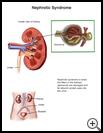
Nephrotic Syndrome
________________________________________________________________________
KEY POINTS
- Nephrotic syndrome is when the filters in the kidneys are damaged and let too much of the body’s protein (albumin) pass into the urine.
- The treatment of nephrotic syndrome depends on the cause. Sometimes it will get better on its own. Sometimes it gets worse and leads to kidney failure. In serious cases, your child may need dialysis.
- Follow the full course of treatment prescribed by your child’s healthcare provider. Give all medicines exactly as directed by your child’s provider. Ask your child’s healthcare provider how to take care of your child at home.
________________________________________________________________________
What is nephrotic syndrome?
Nephrotic syndrome is when the filters in the kidneys are damaged and let too much of the body’s protein (albumin) pass into the urine.
The kidneys are inside the belly, on either side of your spine just above the waist. They make urine by removing waste products, extra salt and other minerals, and water from the blood. Glomeruli are the tiny filters in the kidneys that help remove waste products from the blood.
What is the cause?
Nephrotic syndrome may be inherited, which means that it is passed from parents to children through their genes. Genes are inside each cell of your body. They contain the information that tells your body how to develop and work.
Nephrotic syndrome may also be caused by anything that harms the filters in the kidney such as:
- Infection in the kidneys or blood
- Autoimmune disease, which is a disease that causes the body to mistakenly attack its own tissue such as lupus
- Certain medicines such as nonprescription pain medicines and some antibiotic medicines
- Injury to the kidneys from an outside force such as a car accident, fall, or gunshot wound
What are the signs and symptoms?
Your child may not have symptoms. If your child has signs and symptoms, they may include:
- Too much protein in your child’s urine
- Not enough protein in your child’s blood
- Too much cholesterol and fat in your child’s blood
- Frothy or foamy urine
- Bloody urine
- Swelling in your child’s face or any place on the body
- Weight gain
- High blood pressure
- Diarrhea
- Decreased appetite
- Signs of infection such as fever and not feeling well
How is it diagnosed?
Your child’s healthcare provider will ask about your child’s symptoms and medical history and examine your child. Tests may include:
- Blood tests
- Urine tests
- Ultrasound scan, which uses sound waves to show pictures of the kidneys
- CT scan, which uses X-rays and a computer to show detailed pictures of the kidneys
- Kidney biopsy, which is the removal of a small piece of tissue from the kidney for tests
How is it treated?
The treatment of nephrotic syndrome depends on the cause. Your healthcare provider may prescribe medicines to treat your child’s blood pressure and remove extra fluid from the body.
Sometimes it will get better on its own. Sometimes it gets worse and leads to kidney failure. In serious cases, your child may need dialysis.
Dialysis uses a machine to do the work of your child’s kidneys. It removes waste products and extra water from your child’s blood and can be life saving. Dialysis usually needs to be done several times a week.
Your child may need a kidney transplant.
How can I take care of my child?
Follow the full course of treatment prescribed by your child’s healthcare provider. Give any medicines exactly as directed by your child’s provider.
- Help your child eat a variety of healthy foods. Ask your child’s provider and dietitian:
- If there are any foods your child should avoid
- What the right amount of sodium is for your child each day
- How much liquid your child should have each day
Ask your child’s provider:
- How and when you will get your child’s test results
- How long it will take your child to recover
- If there are activities your child should avoid and when your child can return to normal activities
- How to take care of your child at home
- What symptoms or problems you should watch for and what to do if your child has them
For more information, contact:
- National Kidney Foundation
800-622-9010
https://www.kidney.org/
Last modified: 2022-07-05
Last reviewed: 2018-06-29

